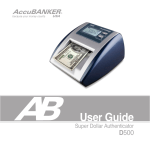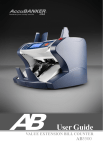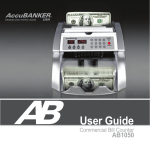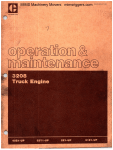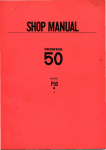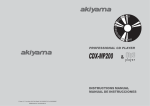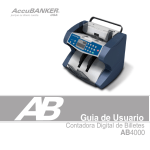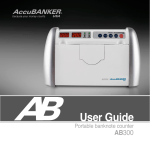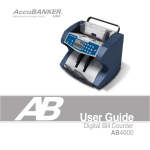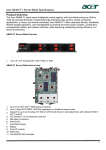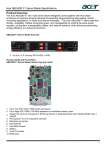Download User Guide - Grupo Cuenca
Transcript
User Guide Multi-Currency Value Counter AB7000 2 Thank you for purchasing this AccuBANKER product. We recommend reading all information in the user guide to become familiar with this product. AccuBANKER and its logo are registered trademarks of Hilton Trading Corp. All Rights Reserved. 3 Table of Contents Getting Started: Important Safety Instructions Other Safety Considerations Introduction Box Contents Installation and Transportation 1. Power Up . . . . . . . . . . . . . . . . . . . . . . . . . . . . . . . . . . . . . . . 11 12 1.1 Notes Selection. . . . . . . . . . . . . . . . . . . . . . . . . . . . . 1.3 Thickness Knob Adjusting Procedure . . . . . . . . . . . . 12 1.2 Initializing Procedure . . . . . . . . . . . . . . . . . . . . . . . . 11 1.4 Currency Selection. . . . . . . . . . . . . . . . . . . . . . . . . . 12 2. General Parts and Controls. . . . . . . . . . . . . . . . . . . . . . . . . . . . . . 13 14 1.5 Operating Mode Selection. . . . . . . . . . . . . . . . . . . . . 12 2.1 Parts Description. . . . . . . . . . . . . . . . . . . . . . . . . . . . 13 2.3 Functions. . . . . . . . . . . . . . . . . . . . . . . . . . . . . . . . . . 15 2.2 Control Panel Description. . . . . . . . . . . . . . . . . . . . . 3. Basic Operation. . . . . . . . . . . . . . . . . . . . . . . . . . . . . . . . . . . . . . . . . . 19 3.1 VALUE Mode. . . . . . . . . . . . . . . . . . . . . . . . . . . . . . . 19 3.1.1 Counting Details. . . . . . . . . . . . . . . . . . . . . . 19 3.1.2 Entering the Denomination Value Manually 4 20 Table of Contents 3.2 SORT Mode. . . . . . . . . . . . . . . . . . . . . . . . . . . . . . . 21 3.4 DISPENSE Mode. . . . . . . . . . . . . . . . . . . . . . . . . . . 22 3.3 COUNT Mode. . . . . . . . . . . . . . . . . . . . . . . . . . . . . . 21 3.4.1 OVERVALUE Event. . . . . . . . . . . . . . . . . . 23 4. Trobleshooting Operational Problems. . . . . . . . . . . . . . . 24 4.1 Avoiding Problems. . . . . . . . . . . . . . . . . . . . . . . . . . 4.2 Removing Jammed Notes. . . . . . . . . . . . . . . . . . . . 24 24 5. Warning and Error Messages. . . . . . . . . . . . . . . . . . . . . . . 26 6. Unit Maintenance. . . . . . . . . . . . . . . . . . . . . . . . . . . . . . . . . 27 6.1 Daily Maintenance. . . . . . . . . . . . . . . . . . . . . . . . . . 27 7. Unit Specifications. . . . . . . . . . . . . . . . . . . . . . . . . . . . . . . 28 6.2 Weekly Maintenance. . . . . . . . . . . . . . . . . . . . . . . . 5 27 Important Safety Instructions ! Warning Do not use this product in areas where it may be exposed to water or other liquids. Unplug this product from the wall outlet before cleaning. Do not use liquid or aerosol cleaners. Use a damp cloth for cleaning. To reduce the risk of electric shock, do not disassemble this product. Take it to qualified service personnel when service or repair work is required. Opening or removing covers may expose you to dangerous voltages or other risks. Incorrect re-assembly can cause electric shock when the appliance is subsequently used. Only use the cable provided with the unit. The use of other cables may result in electric shock, fire or cause serious damage to the unit. Do not operate the unit in areas with high temperature or high humidity since it may prevent it from working correctly. ! Caution When unplugging the power cord, do not pull it by the cord, but rather grip the plug to pull it out. Not following these instructions may result in electric shock, fire or damage to the unit. Do not use the unit if the power cord is damaged or if the plug socket contact is loose. Not following these instructions may result in electric shock, fire or other hazards. Do not place heavy objects over the cord and do not bend it excessivel since it could get damaged. Not following these instructions may result in electric shock, fire or other hazards. When not using the unit for a long period of time, remove the power plug from the wall outlet. 6 Other Safety Considerations • Read and understand all of the safety instructions. • Follow all warnings and instructions marked on the unit. • This product should never be placed near or over a radiator or heater register. This product should not be placed in a built-in installation unless there is proper ventilation. • This product should be operated only from the type of power source indicated in this user’s guide. If you are not sure of the type of power supply in you location, consult your dealer or local power company. • Never push objects of any kind into the unit through the case slots or openings, since they may touch dangerous voltage points or shortcut parts, resulting in a risk of fire or electric shock. • Never spill liquids of any kind on the product. • Unplug this product from the wall outlet and refer to servicing by qualified service personnel under the following conditions: When the power supply cord or plug is damaged or frayed. If liquid has been spilled into the unit. If the unit has been exposed to rain or water. If the unit does not operate normally while following the operating instructions, adjust only those controls that are covered by the operating instructions. Improper adjustment of other controls may result in damage and will often require extensive work by a qualified technician to restore the product to normal operation. - If the product has been dropped or the case has been damaged. - If the product shows a noticeable change in performance. - 7 Introduction The AB7000 Multi-Currency Value Counter unit is the perfect solution for a fast, accurate and reliable banknote counting process. This banknote Value Counter machine is designed to meet the most demanding applications in the financial branch. Its four operating modes (VALUE, SORT, DISPENSE and COUNT) give this unit a versatility that makes it adaptable to any financial task. This feature combined with its six counterfeit detection functions (UV, MG, IR, MT, DD and 3D) makes this unit an indispensable tool for the financial market of today. A simple and friendly user interface as well as its high resolution LCD display will allow you to save time and money during your management accounting operations. This User Guide covers the Installation, Operation and Troubleshooting procedures of the AB7000 Multi-currency Value Counter. We recommend reading this guide thoroughly before operating the AB7000 unit in order to become familiar with its functions. 8 Box Contents When opening the box, verify that all of the items described below are included. If any item is damaged or missing, contact the place where the unit was purchased. 1. Value Counter unit AB7000 2. Power Cord 3. User Guide, Warranty and promotional materials 9 Installation and Transportation A) Unpacking the unit After unpacking the unit, store the box and the packing material for future shipping. Failing to ship the unit in its original unit box and Styrofoam will void the unit’s warranty. B) Installation • Select an appropriate workspace and make sure it is clean, flat and leveled. • The unit should never be placed near or over radiator or heater registers as well as far from strong source of lights. • Operate on only the following power sources: 120 VAC/60 Hz, (American Standard) or 240 VAC/50 Hz, (European Standard) • Plug the power cable to the back of the unit and into the wall outlet. • Turn the unit on and verify its functioning. In case any functioning problem; get contact immediately with your provider. Note: When replacing fuses, make sure to use the same type and rating. C) Carrying the unit When lifting or moving the unit around, make sure to carry the unit as the picture shows, if you don’t, any part may result damaged or could exist the risk of falling down. Beneath the Control Panel Handle Slot 10 1. Power Up 1.1 Notes Selection For ensuring a trouble-free unit’s operation make sure: 1. Avoid counting wet, excessively dirty, folded or curved notes. 2. Check for foreign objects mixed up with the bills like paper clips, rubber bands, pieces of paper etc. $$ $$ $$ $$ $ 3. Fan each bundle before counting in case the notes are slightly adhesive one each other. 4. Make sure to put the notes on the hopper in an orderly manner WRONG POSITIONING PROPER POSITIONING X AB7000 DD Speed Level 3D Batch 2 3 5 7 8 9 Value Clear 4 AB7000 Mode 0 MT ADD A/M 1 UV MG Start MT ADD MC Menu Set 11 A/M DD Speed Level 3D Batch 1 2 3 5 7 8 9 Value 0 MG 9 UV 9 Mode Clear 4 Start MC Menu Set 1.2 Initializing Procedure 1. After turning On, the unit will conduct a self-check procedure by spinning the rollers and showing the message “AccuBANKER-AB7000” on the LCD display meanwhile all the electronic components are tested. 2. After finishing the self-check procedure, the unit wakes up into the same working mode which it was before being turned off. Now the unit is ready to start counting. 3. If an error message appears on the display, proceed in accordance with the instruction given in the Section 5. 1.3 Thickness Knob Adjustment Procedure 1. The Thickness Adjustment Knob is set at 0 as the standard setting from factory. 2. Having the right thickness adjustment knob positioning will ensure a smooth counting as well as a trouble-free operation. 3. Trial and error attempts are recommended before you make the final adjustment. a. for new (thinner) notes, adjust toward “-“ b. for used (thicker) notes, adjust toward “+” c. small adjustment toward “+” direction works best Increase thickness gap 1.4 Currency Selection 0 + _ Reduce thickness gap MC Menu Pressing the “MC” button, select the currency (Currency Nationality) to count among the options available. Pressing it sequentially will show all the options available. 1.5 Operating Mode Selection Mode Using the “Mode” button, select the desired working mode among the VALUE, SORT, COUNT and DISPENSE. Value Mode Sort Mode Count 12 Mode Mode Dispense 2. General Parts and Controls 2.1 Parts Description 1 1. Hopper Guiders 2 2. Hopper 3 AB7000 A/M Level 3D Value 9 8 0 DD ADD 4. Control Panel 7 Start 9 3. Hopper sensor 3 5 4 MT IR 2 1 MG UV Mode Clear MC Menu 4 Set Batch Speed 5. Stacker 5 6 6. Stacker sensor 7. Emergency stop button 8. Bill Thickness Adjustment knob 9. Accessible Back Cover 10. Handle slot 11. RS-232 port 12. USB port 7 8 9 10 13. Power Switch 14. Power Outlet 11 13 12 14 13 2.2 Control Panel Description Button Functions • MODE: Used to select the specific working mode among VALUE / SORT / COUNT and DISPENSE. • ADD: Adding function ON / Off . • A/M: Automatic or Manual starting mode. • SPEED: Select the counting speed between 750, 1200 or 1500 bills/min. • UV: Ultraviolet Detection function. • MG: Magnetic Ink Detection function. • IR: Infrared Marks Detection function • MT: Metal Thread Detection function. • DD: Width Size Detection function ON / OFF. Available just for 900 and 1200 bills/min. • 3D: Width and Length Size Detection function ON / OFF. Available just for 900 bills/min. • LEVEL: It adjusts the Sensitivity of the Counting Sensors. Lev-1 is the lowest and Lev-4 is the highest sensitivity. • BATCH: By pressing the BATCH button sequentially, the preset batching value 14 • VALUE: It allows the user to view the details of the counting (breakdown). Both, the Quantity (PCS) and Amount per denomination are shown, as well as the Grand Total amount. • CLEAR: Used for clearing both error messages and counting data to “0”. • MC/MENU: Multi-Currency function is used for selecting other currency to count. • SET: Used for setting and confirm the user parameters. • START: Used for starting counting as well as confirmation action. • Numeric Keys (0-9): Are used for selecting the batching number as well as to enter the specific denomination value when the unit asks it. In Dispense mode the numeric keys are used to enter the desired amount to dispense. 2.3 Functions • ADD function ADD The Adding function allows summing all the operation results and obtains the total number of bills as well as the accumulated amount. ADD function is available in the four working modes. Note: the CLEAR key is used to clear (erase) the current results before starting a new sequence of countings. AUT Quantity of notes in the last one counting VALUE USD ADD 100 $ pcs 15 2650 500 Total Amount Total Quantity • SPEED selection Speed It selects the counting speed between 750 (Low), 1200 (Normal) or 1500 (Fast) bills/min. When the unit is working on VALUE, SORT or DISPENSE mode, the speed will be set up to 750 bills/min automatically. • BATCH function Batch It selects the preset batching value among 10, 20, 50, or 100 bills. The preset batch selection is displayed on the screen. In case a different batching value is required, the user could select it directly using the numeric keys. • UV Ultraviolet Fluorescence Detection Function UV Pressing the UV button sequentially the user is able to select a specific setting for this function considering the specific sensitivity required for the counting or even disable it (UV-1, UV-2, UV-3, UV-4 and OFF). UV function is able to check all types of banknotes containing UV features and alert the user in case it fails with the warning message “SUSPECT NOTE-UV” on the screen. Note: UV-1 is the lowest sensitivity level and UV-4 is the highest sensitivity level. • MG Magnetic Detection Function MG Pressing the MG button sequentially the user is able to select a specific setting for this function considering the specific sensitivity required for the counting or even disable it (MG-1, MG-2, MG-3, MG-4 and MG-OFF). MG function is able to check all types of banknotes containing magnetic ink and alert the user in case it fails with the warning message “SUSPECT NOTE-MG” on the screen. Note: MG-1 is the lowest MG sensitivity level and MG-4 is the highest MG sensitivity level. 16 • Infrared Detection Function IR This function allows the unit to verify the security infrared marks present on the banknotes. The sensitivity options are IR-1 and IR-OFF. In case it fails the warning message “SUSPECT NOTE-IR” will be displayed on the screen. • Metal Thread Detection Function MT This function allows the unit to verify the security metal thread embedded into the banknotes. The sensitivity options are MT-1, MT-2, MT-3, MT-4 and MT-OFF. In case it fails the warning message “SUSPECT NOTE-MT” will be displayed on the screen. • Width Size Evaluation DD This function allows the unit to memorize the width size of the first note and uses it as a pattern to compare the rest of the notes during the counting. The sensitivity options are DD-1 (5 mm), DD-2 (4 mm), DD –3 (3 mm), DD –4 (2 mm) and DD -OFF. In case it fails the warning message “DIMENSION WIDTH ERROR” will be displayed on the screen. This function is available just for COUNT mode in 900 (Low) and 1200 (Normal) counting speeds. Note: In order to obtain the best performance of this function, make sure to place the bills on the hopper in an orderly manner. • Length Size Evaluation 3D This function allows the unit to memorize the length size of the first note and uses it as a pattern to compare the rest of the notes during the counting. The sensitivity options are 3D-1 (5 mm), 3D -2 (4 mm), 3D –3 (3 mm), 3D –4 (2 mm) and 3D -OFF. 17 In case it fails the warning message “LENGTH ERROR” will be displayed on the screen. This function is fully available for VALUE, SORT and DISPENSE modes. In COUNT mode it is limited to 900 (Low) and 1200 (Normal) counting speeds. Note: For obtaining the best performance of this function, make sure to place the bills on the hopper in an orderly manner. • Level Function Level This function allows the unit to verify the density of each note during the counting. Suspicious bills as well as double notes feeding incidents will be detected immediately. The sensitivity options are LEV-1, LEV -2, LEV -3, LEV -4 and LEV -OFF. In case it fails, the warning message “DOUBLE NOTES ERROR” will be displayed on the screen. • MULTICURRENCY Selection MC Menu This function allows the user to select the specific currency to count among the options available. By pressing the “MC” button the display will show sequentially the different currency options. Now the unit is ready to count your selected currency. 18 3. Basic Operation Operating Modes Mode The unit comprises four operation modes that are selected by pressing the MODE button sequentially. Using the “Mode” button, the user selects the desired working mode among the VALUE, SORT, COUNT and DISPENSE. 3.1 VALUE Mode VALUE In this mode the unit counts the quantity of bills as well as recognizes (discriminates) every denomination included in a mixed-denominations stack of banknotes. Both data, QUANTITY of bills and GRAND-TOTAL VALUE are shown on the display after the counting is finished. 3.1.1 Counting Details VALUE When the unit finishes the counting in Value mode the screen will show both data, the QUANTITY of notes and the TOTAL VALUE included into the stack of notes already counted. Additional information regarding the counting result could be obtained by pressing the “VALUE” button. A full breakdown of the counting will be shown on the display detailing the number of notes and the total amount belonging to every specific denomination. Note: The numeric keys “2 (up)”and “8 (down)” will help the user to visualize the entire information on the screen. VALUE AUT ADD $ pcs 2650 120 PCS $ 1x 2x 5x 10 x 30= 10= 20= 10= 30 20 100 100 TOTAL 120 2650 DEN PCS DEN USD VALUE 19 8 $ 20 x 50 x 100 x 20= 20= 10= 400 1000 1000 TOTAL 120 2650 2 3.1.2 Entering the Denomination Value Manually While counting in VALUE mode, any bill not recognized satisfactorily by the CIS sensor, will suddenly stop the unit and will show the message “NOT RECOGNIZED - ENTER VALUE OR REMOVE” on the display. It could happen because of the fitness condition of the note is not so well or it is too dirty, driving the recognition process to fail. Note: The suspicious bill will be located at the unit’s stacker; it is the last one that reached the stacker. The user must proceed as follow: a. Remove the suspicious note from the stacker and verify its authenticity by yourself. b. If it is considered genuine, return it to the stacker and enter its denomination using the numeric keys and press START. Then confirm its value pressing START again. c. At this moment the specific value will be added to the current Grand-Total Value. d. On the other hand if it considered as a faked note, keep it apart, and press START for resuming the counting. 20 3.2- SORT Mode Mode Used to sort out a specific denomination from a stack of notes mixed in denominations. Each time the unit begins processing a new stack of bills in this mode, it recognizes and “memorizes” the denomination of the first note scanned. During the sorting process if the unit detects a note with a different denomination, the counting will be stopped for allowing the user take it apart from the rest of bills. The message “DENOM ERROR - REMOVE NOTE FROM STACKER” will come out on the screen. Only the notes that belong to the denomination “memorized” by the unit are going to be considered into the final results of QUANTITY of bills and GRAND-TOTAL VALUE. SORT AUT USD START DENOM ERROR pcs 3.3- COUNT Mode REMOVE NOTE FROM STACKER 0 0 $ & PRESS START Mode In this mode the unit works as a standard bill counting machine. It will count the quantity of notes without denomination recognition. The final result will be only the total quantity of notes included into the stack. AUT COUNT pcs 21 USD 0 3.4 DISPENSE Mode Mode In this mode the unit works as a cash dispenser device. It means, the user place a stack of bills (mixed or not) in the unit’s hopper and enter the exact amount of money to be dispensed by the unit. The unit starts to dispense money until reaching the exact amount set up by the user previously. Proceed as follows: a. Enter the desired amount using the numeric keys (fig. A) b. Confirm the amount by pressing “START” button (fig. B) c. The Unit will ask you one last confirmation (fig. C) d. The unit will dispense the desired amount (fig. D) 22 3.4.1 OVERVALUE event During dispensing there is a possibility that the unit exceed the amount of money set up by the user previously because of there are several denominations mixed up into the stack of money placed on the hopper. In this case, the unit will stop dispensing immediately and the warning message “OVERVALUE” will come out on the display. The user must proceed to remove the wrong amount from the stacker and resume the dispensing operation. AUT $ DISPENSE XXX pcs OVERVALUE 23 USD xx 4. Troubleshooting Operational Problems 4.1 Avoiding problems Pre-select the notes you are going to count in the unit. Don’t attempt to count bills: a. with staples, metal clips, rubber bands or any other object b. torn, washed or damaged c. profusely stained d. covered with any type of adhesive substance 4.2 Removing Jammed notes In case the unit stops suddenly due to a bill jamming event, please follow this procedure for removing it without damaging the unit. Don’t try to put any object in through the unit’s slots. 1. Remove all the banknotes from the Hopper and Stacker. 2. Turn the unit off. 3. Unplug the power cord from the unit. (Fig. A) 4. Open the back cover by loosening the two screws using your fingers. (Fig. B) 5. Press both tabs, the left one and the right one (arrows in yellow) with your fingers simultaneously until unlocking the inner cover. (Fig. C) 6. Pull the inner cover outwards to gain access inside the unit. (Fig. D) 7. Carefully remove the jammed note and check in case any other object or a piece of note remains inside. (Fig. E) 8. Replace the inner cover and push it firmly until you hear a click that means it is completely closed. 9. Close the back cover and tighten the screws. 10. Plug the power cord back on and turn the unit on. 11. Place the notes on the hopper and resume the counting. 24 25 5. Warning and Error Messages The following error messages will appear on the display in case the unit detects any anomaly during its functioning. This chart will show the user how to proceed with them. 26 6. Unit Maintenance To make sure the operation of the unit is as trouble-free as possible, perform the following maintenance procedures: 6.1- Daily Perform the following steps on a daily basis: a. Turn Off the unit when not in use. b. Use the protective cover when the unit is not in use. c. With a clean dry cloth or a brush dust off the hopper and stacker areas carefully. 6.2- Weekly Perform the following steps on a weekly basis: a. Turn off the unit and unplug its power cord. b. Open the back cover carefully. c. Use an air duster can and a brush to remove the dust from the bill passages areas. d. Use a cloth soaked in alcohol to clean the CIS sensor surface in case it has residues of ink from the notes. Note: follow the same procedure given in “Removing Jammed notes” section to gain access to the CIS sensor. 27 7. Unit Specifications Counting Speed: Variable, 750 / 1200 / 1500 notes/min. Discrimination Modes: VALUE, SORT, DISPENSE and COUNT Technology: CIS (Contact Image Sensor) Currencies Available: USD ( optional MXN-BRL and others) Counterfeit Detection: UV-MG-IR-MT-DD-3D Interfaces: USB port: Software Installation procedure. RS-232 port: Printer or External Display connection. Display: High Resolution LCD display. Hopper Capacity: 500 notes Stacker Capacity: 200 notes Banknote size range: 100mm x 50mm - 170mm x 90mm Power Requirements: 100-240 VAC, 50-60 Hz Power Consumption: < 35 W ; 6 W (stand by) Size (W x D x H): 11” x 9 ¾” x 11” (280mm x 248mm x 280mm) Weight: 13.5 lbs / 6.20 Kg 28 Notes Notas 7. Especificaciones Velocidad de Conteo: Variable, 750 – 1200 – 1500 billetes / min Modos de Operación: VALOR (VALUE), SELECCIÓN (SORT), DISPENSADOR (DISPENSE) y CONTEO (COUNT) Tecnología de Detección: CIS (Sensor de Imagen por Contacto) Monedas Disponibles: USD ( MXN-BRL y otras opciones que requiera el usuario) Funciones de Detección: UV-MG-IR-MT-DD-3D Interfases: USB – Instalación del Software RS-232 – Conexión de Impresora y Pantalla Externa Display: Pantalla de LCD de alta resolución. Capacidad de la Bandeja de Entrada: 500 billetes Capacidad de la Bandeja de Salida: 200 billetes Dimensiones de los Billetes: 100mm x 50mm - 170mm x 90mm Voltaje de Alimentación: 100-240 VAC, 50-60 Hz Consumo de Energía: < 35 W ; 6 W (stand by) Dimensiones (W x D x H): 11” x 9 ¾” x 11” (280mm x 248mm x 280mm) Peso: 13.5 lbs / 6.20 Kg 28 6. Mantenimiento Periódico Siga las siguientes recomendaciones para minimizar los posibles errores durante el funcionamiento de la unidad y alargar la vida útil de la misma. 6.1 Diariamente Proceda como sigue diariamente: a. Apague la unidad mientras no está siendo operada. b. Proceda a cubrirla con el protector de polvo cuando no está siendo operada. c. Al final de cada sesión de trabajo use un paño para retirar el polvo y suciedad acumulada durante el dia. 6.2 Semanalmente Proceda como sigue semanalmente: a. Apague la unidad y desconecte el cable de alimentación. b. Abra la cubierta trasera y la cubierta interior para acceder al interior de la unidad (sección 4.2). c. Use una brocha y aire limpio comprimido para retirar el polvo y la suciedad acumulada en el interior de la unidad y el mecanismo de transporte. d. Use un paño limpio humedecido en alcohol para limpiar adecuadamente el sensor CIS así como los rodillos de transporte. Nota: Asegúrese de proceder cuidadosamente para evitar cualquier daño a la unidad durante este procedimeinto. 27 5. Mensajes de Error Los siguientes mensajes de error aparecerán en la pantalla en caso de que la unidad detecte algún tipo de anomalía durante su funcionamiento. Esta tabla muestra como proceder en cada caso. ERROR POSIBLE CAUSA SOLUCION 1- Retire el billete dañado 1-La mitad de un billete fue detectado Limpie el sensor de salida o verifique si existe algún obstáculo en la bandeja. Existe algún obstáculo en el sensor de salida (billetes, polvo u otro objeto) CHECK STACKER Limpie el sensor de entrada o verifique si existe algún obstáculo. Existe algún obstáculo en el sensor de entrada (billetes, polvo u otro objeto) CHECK HOPPER SENSOR HALF-SIZED NOTE ERROR CHAIN NOTES ERROR DOUBLE NOTES ERROR 2- Un billete de menor tamaño pasó por un 2- Alinear los billetes adecuadamente y solo sensor de conteo posicionarlos en el centro de la bandeja de entrada Se detectaron dos billetes que pasaron muy El ajuste de espesor pudiera estar muy abierto, unidos sin intervalo entre ellos. ajústelo adecuadamente y reinicie el conteo. 1-Dos billetes pasaron simultáneamente 2- Se detectó un billete de un contraste diferente o muy sucio o maltratado 1- El ajuste de espesor pudiera estar muy abierto, ajústelo adecuadamente y reinicie el conteo. 2- La sensibilidad de la función LEVEL pudiera estar muy alta, ajústela a un nivel más bajo Fue detectado un billete con características Retire el billete de la bandeja de entrada y SUSPECT NOTE - UV UV sospechosas verifíquelo manualmente o use un detector Fue detectado un billete con características Retire el billete de la bandeja de entrada y MG sospechosas verifíquelo manualmente o use un detector SUSPECT NOTE - MG Fue detectado un billete con características Retire el billete de la bandeja de entrada y IR sospechosas verifíquelo manualmente o use un detector SUSPECT NOTE - IR Fue detectado un billete sin el hilo de Retire el billete de la bandeja de entrada y seguridad verifíquelo manualmente o use un detector SUSPECT NOTE - MT DENOM ERROR REMOVE NOTE FROM STACKER &PRESS START En modo SORT: Una denominación diferente a la "almacenada" en memoria fue detectada NOT RECOGNIZED ENTER VALUE OR REMOVE La unidad no reconoció la denominación presente en uno de los billetes Retire el billete de la bandeja de salida y prosiga con el conteo presionando START. Entre el valor de la denominación manualmente usando las teclas numéricas y presione START O retire el billete y colóquelo en la bandeja de entrada para otra comprobación. &PRESS START STACKER IS FULL La bandeja de salida alcanzó el máximo de 1- Retire los billetes de la bandeja de salida y 200 billetes presione START para proseguir el conteo. 1- Retire el billete de la bandeja de salida DIMENSION WIDTH Un billete de un ancho diferente fue 2- Verifíquelo manualmente o con un detector detectado ERROR 3- Presione START para continuar el conteo 4- Considere ajustar (bajar) la sensibilidad de DD 1- Retire el billete de la bandeja de salida LENGTH ERROR Un billete de un largo diferente fue 2- Verifíquelo manualmente o con un detector detectado 3- Presione START para continuar el conteo 4- Considere ajustar (bajar) la sensibilidad de 3D 26 25 4. Solución a Problemas Operacionales 4.1 Minimizando los errores Se recomienda preseleccionar los billetes que van a ser contados. No intente contar billetes: a. con presillas, ligas u otro tipo de objetos extraños b. que estén muy gastados, manchados o maltratados c. cubiertos con algún tipo de adhesivo 4.2 Billetes Atorados En caso de que algún billete se atore en la parte interior de la unidad, proceda como se indica a continuación. No intente acceder al interior de la unidad con objetos punzantes lo que pudiera traer como consecuencia un daño irreversible de la unidad. 1. Retirar todos los billetes de las bandejas de entrada y salida. 2. Apagar la unidad completamente. 3. Desconectar el cable de alimentación de la parte trasera. (Fig. A) 4. Abrir la cubierta trasera aflojando los tornillos manualmente. (Fig. B) 5. Presionar ambos mecanismos de agarre simultáneamente (marcas amarillas) hasta que se libere la cubierta interior. (Fig. C) 6. Abrir la cubierta interior hacia fuera cuidadosamente ya que el CIS sensor queda al descubierto y retirar el billete atorado del interior de la unidad con sus propias manos. (Fig. D) 7. Revisar que no haya quedado otro objeto o pedazo de billete en el interior de la unidad. (Fig. E) 8. Cerrar la cubierta interior y presionarla firmemente hasta sentir que el mecanismo cierre. 9. Cerrar la cubierta exterior y apretar los tornillos otra vez. 10. Conectar el cable de alimentación y encender la unidad. 11. Retomar el conteo de billetes. 24 3.4.1 Sobregiro del Valor Dispensado Mientras la unidad trabaja en modo Dispensador se puede dar el caso de que el valor dispensado sobrepase la cifra previamente solicitada por el usuario. Este incidente se debe a la disposición aleatoria de las distintas denominaciones dentro del fajo de billetes. En este caso la unidad se detendrá inmediatamente y el mensaje de “OVERVALUE” aparecerá en la pantalla alertando al usuario de este incidente. El usuario debe retirar la cantidad errónea dispensada y volver a entrar la cantidad deseada, asegurándose de que esta es posible de alcanzar considerando la denominación de los billetes localizados en la bandeja de entrada. AUT $ DISPENSE XXX pcs USD xx OVERVALUE 23 3.4 Modo DISPENSADOR (DISPENSE) Mode En este modo la unidad trabaja como un dispositivo Dispensador de Efectivo. Esto significa que el usuario coloca un fajo de billetes (mixtos o no en denominaciones) en la bandeja de entrada de la unidad y solicita a la contadora que dispense una cantidad determinada de efectivo. La unidad comienza a dispensar y verificar el efectivo y se detendrá al alcanzar exactamente la cifra previamente solicitada por el usuario. La pantalla tambien mostrará la cantidad total de billetes comprendidos en dicha cantidad. Nota: La función “VALUE” para mostrar los detalles del conteo está disponible en este modo. Proceda como se indica a. Seleccione la cantidad a dispensar usando las teclas numéricas (fig. A) b. Valide la selección presionando la tecla START (fig. B) c. Confirme nuevamente la cantidad (fig. C) d. La unidad dispensara el monto solicitado (fig. D) 22 3.2- Modo SELECCIÓN ( SORT) Mode Este modo de operación es usado para extraer de un fajo de billetes de denominaciones mezcladas todas aquella denominaciones distintas a una previamente seleccionada. Cada vez que la unidad comienza un ciclo de conteo en este modo, la unidad “Memoriza” la denominación del primer billete del fajo y la usa como patrón de comparación para el resto de los billetes. Si durante el conteo la unidad detecta una denominación distinta a la almacenada en memoria, esta se detiene inmediatamente y la pantalla mostrará el mensaje “DENOM ERROR - REMOVE NOTE FROM STACKER”. Permitiendo al usuario retirar dicho billete de la bandeja de salida y así hasta concluir el fajo. Nota: El resultado final de cantidad de billetes y monto total solo corresponderá a la denominación “Memorizada” por la unidad. AUT SORT USD START DENOM ERROR $ pcs 0 0 3.3- Modo CONTEO (COUNT) REMOVE NOTE FROM STACKER & PRESS START Mode En este modo la unidad opera como una contadora de billetes convencional. Cuenta y verifica (sin reconocer denominación) los billetes que se coloquen en la bandeja de entrada. El resultado final obtenido en la pantalla es la CANTIDAD total de billetes en el fajo contado. Nota: Las tres velocidades de conteo están disponibles en este modo. AUT COUNT USD 0 pcs 21 3.1.2 Validación Manual de la Denominación Durante el conteo en modo VALOR, puede darse el caso de que la unidad no pueda reconocer satisfactoriamente la denominación correspondiente a un billete. Esto puede suceder en caso de que el billete este muy desgastado, sucio o manchado y el Sensor de Imagen no sea capaz de reconocerlo. La unidad se detiene inmediatamente y el mensaje “NOT RECOGNIZED -ENTER VALUE OR REMOVE” es mostrado en la pantalla. Nota: El billete problemático estará localizado en la bandeja de salida de la unidad. El usuario debe proceder como sigue: a. Retirar el billete problemático de la bandeja de salida y verificarlo manualmente o con la ayuda de un detector. b. Si es considerado genuino, reponerlo en la bandeja de salida y entrar su denominación manualmente por medio de las teclas numéricas y presionar START. Presione START otra vez para confirmar dicho valor c. En este momento dicho valor será adicionado al VALOR TOTAL del conteo. d. Por otra parte, si el billete hubiera sido considerado falso o no apto para considerarlo en el conteo, presione START directamente desde la primera vez que la unidad lo detectó. 20 Modos de Operación 3. Funciones Operacionales Mode La AB7000 comprende cuatro Modos de Operación dependiendo de la necesidad del usuario. Estos son seleccionados presionando secuencialmente la tecla MODE. Cada modo tiene sus características y especificaciones como se muestra a continuación. 3.1- Modo VALOR (VALUE) Mode En este modo la unidad cuenta la cantidad de billetes a la vez que identifica cada una de sus denominaciones. La pantalla mostrará la CANTIDAD TOTAL de billetes contados así como el VALOR TOTAL del conteo. 3.1.1 Detalles de Conteo VALUE Cuando la unidad termina su conteo en modo Valor, la pantalla muestra la cantidad total de billetes y el valor total del conteo. Una información más detallada puede ser obtenida al presionar la tecla “VALUE”, la cual muestra en la pantalla un reporte detallado de la Cantidad de Billetes por cada denominación así como el Monto (Valor) Parcial aportado por cada denominación. Nota: Las teclas numéricas “2 (Arriba) y 8 (Abajo)” son usadas para mostrar toda la información de la pantalla. AUT VALUE 120 TOTAL 30 20 100 100 30= 10= 20= 10= 1x 2x 5x 10 x $ PCS DEN USD ADD $ pcs 2650 120 VALUE DEN PCS 120 TOTAL 20= 20= 10= 20 x 50 x 100 x 8 2650 $ 400 1000 1000 2 2650 19 • Verificacion de Longitud del Billete 3D Mediante esta función la unidad “memoriza” y usa como patrón el “Largo” del primer billete procesado. A partir de este momento, los demás billetes que pertenecen al mismo ciclo de conteo serán comparados con esta dimensión para detectar una variación en el largo de los billetes. Si algún billete es considerado sospechoso porque la variación en tamaño sobrepasa la tolerancia permitida, el mensaje “LENGHT ERROR” aparecerá en la pantalla. Las sensibilidades disponibles son 3D-1 (5 mm), 3D -2 (4 mm), 3D –3 (3 mm), 3D –4 (2 mm) y 3D -OFF. Nota: Esta función está completamente disponible para los modos VALUE, SORT y DISPENSE. Para modo COUNT esta función esta limitada a las velocidades de 750 (Baja) y 1200 (Normal). Nota: Para un mejor desempeño de la unidad con esta función, se recomienda ubicar los billetes en la bandeja de entrada de forma ordenada. • Verificación de Densidad del Billete Level Esta función permite verificar la densidad de cada billete durante el conteo para evitar que dos billetes pasen unidos y sean considerados como uno solo, evitando así resultados erróneos. Las opciones de sensibilidad disponibles son LEV-1, LEV -2, LEV -3, LEV -4 y LEV –OFF. Si la unidad detecta una densidad sospechosa, el conteo se detiene inmediatamente y el mensaje “DOUBLE NOTES ERROR” aparecerá en la pantalla. • Selección del Tipo de Moneda (Nacionalidad) MC Menu Esta función permite al usuario seleccionar la moneda especifica que se quiere contar. Apretando secuencialmente la tecla “MC” la unidad irá mostrando las opciones disponibles. Después de seleccionarla, la unidad estará lista para reconocer y trabajar dicha moneda. 18 • Función de Detección Infraroja IR Esta función permite verificar las marcas Infrarrojas de seguridad presentes en los billetes. Las opciones disponibles son IR-1 e IR- OFF. En caso de considerarse sospechoso el billete en cuestión el mensaje “SUSPECT NOTE-IR” aparecerá en la pantalla. Nota: Esta función no está disponible para el modo COUNT. • Función de Detección del Hilo de Seguridad MT Esta función permite detectar y validar el hilo de seguridad incrustado en el billete. Las opciones de sensibilidad disponibles son MT-1, MT-2, MT-3, MT-4 y MT-OFF. En caso de que el billete sea considerado sospechoso el mensaje “SUSPECT NOTE-MT” aparecerá en la pantalla y la unidad detendrá el conteo. • Verificación del Ancho del Billete DD Mediante esta función la unidad “memoriza” y usa como patrón el “Ancho” del primer billete procesado. A partir de este momento, los demás billetes que pertenecen al mismo ciclo de conteo serán comparados con esta dimensión para detectar una variación en el ancho de los billetes. Si algún billete es considerado sospechoso porque la variación en tamaño sobrepasa la tolerancia permitida, el mensaje “DIMENSION WIDTH ERROR” aparecerá en la pantalla. Las sensibilidades disponibles son DD-1 (5 mm), DD-2 (4 mm), DD –3 (3 mm), DD –4 (2 mm) y DD -OFF. Nota: Esta función está disponible solo para modo COUNT en las velocidades de 750 (Baja) y 1200 (Normal). Para un mejor desempeño de la unidad con esta función, se recomienda ubicar los billetes en la bandeja de entrada de forma ordenada. 17 • Velocidad de Conteo Speed Selecciona la Velocidad de Conteo entre las opciones 750 (Baja), 1200 (Normal) o 1500 (Rápida) billetes/min. Nota: Cuando la unidad esta trabajando en los modos VALUE, SORT o DISPENSE, la velocidad de conteo es automáticamente ajustada a 750 billetes / min. • Conteo por Agrupamiento o Lotes Batch Selecciona una cantidad especifica de agrupamiento 10, 20, 50, o 100 billetes. La unidad detendra el conteo cada vez que alcance la cifra predeterminada, la cual aparecerá en la pantalla de la unidad. Nota: En caso de necesitarse una cantidad de Agrupamiento distinta a las predeterminadas se podrá ajustar usando las teclas numéricas (0-9). • Función de Detección Ultravioleta UV Presionando secuencialmente esta tecla el usuario puede seleccionar la sensibilidad de Detección Ultravioleta requerida para el conteo, e incluso puede ser deshabilitada (UV-1, UV-2, UV-3, UV-4 y OFF). Esta función permite analizar las características ultravioletas del papel y en caso de considerarse sospechoso la unidad detendrá el conteo y el mensaje “SUSPECT NOTE-UV” aparecerá en la pantalla. Nota: UV-1 es el nivel de sensibilidad más bajo y UV-4 es el nivel de sensibilidad más alto. • Función de Detección Magnética MG Presionando secuencialmente esta tecla el usuario puede seleccionar la sensibilidad de Detección Magnética requerida para el conteo, e incluso puede ser deshabilitada (MG-1, MG -2, MG -3, MG -4 y OFF). Esta función permite analizar las características magnéticas de seguridad del billete, en caso de considerarse sospechoso la unidad detendrá el conteo y el mensaje “SUSPECT NOTE-MG” aparecerá en la pantalla. Nota: MG-1 es el nivel de sensibilidad más bajo y MG-4 es el nivel de sensibilidad más alto. 16 • VALUE: Muestra en la pantalla los detalles del conteo. a. Cantidad de Billetes (PCS) por denominación b. Monto Total ($) por denominación. • CLEAR: Cancela los Mensajes de Error y Borra los datos del conteo previo. • MC/MENU: Selecciona la Moneda (Nacionalidad) a contar. • SET: Usada para Seleccionar los ajustes a realizar por el usuario. • START: Usada para el arranque del conteo en Modo Manual. También usada como confirmación en ciertas operaciones de la unidad. • Teclas Numéricas (0-9): Usadas para seleccionar una cantidad de Batch o Lote distinto a los pre-existentes. En Modo Valor son usadas para confirmar una denominación que no fue reconocida por la unidad. En Modo Dispensador son usadas para entrar la cantidad deseada que la unidad dispense. 2.3 Funciones ADD • Adición Cuando la función Adición esta activada se van sumando las operaciones y acumulando las CANTIDADES de billetes así como el VALOR TOTAL correspondiente. ADD esta disponible en todos los modos de trabajo. Nota: La tecla CLEAR es usada para borrar los datos del conteo anterior antes de comenzar un nuevo ciclo de conteo. AUT Cantidad de Billetes del actual conteo VALUE USD ADD 100 $ pcs 2650 500 Monto (Valor) Total Cantidad Total de Billetes 15 2.2 Panel de Control Controles • MODE: Usado para seleccionar un Modo de Trabajo especifico entre los cuatro disponibles, VALUE (VALOR) / SORT (SELECCION) / COUNT (CONTEO) y DISPENSE (DISPENSADOR) • ADD: Habilita (ON) o Deshabilita (OFF) la función de ADICION . • A/M: Habilita (ON) o Deshabilita (OFF o Manual) la función de Arranque Automático. • SPEED: Selecciona la Velocidad de Conteo entre 750, 1200 o 1500 billetes/min. • UV: Ajuste de la Función de Detección Ultravioleta. • MG: Ajuste de la Función de Detección Magnética. • IR: Ajuste de la Función de Detección Infrarroja. • MT: Ajuste de la Función de Detección del Hilo de Seguridad. • DD: Ajuste de la Función de Verificación del Ancho del Billete. • 3D: Ajuste de la Función de Verificación del Largo del Billete. • LEVEL: Ajuste de la Función de Verificación de Densidad del billete. • BATCH: Función de Agrupamiento o Conteo por Lotes Preseleccionados. Las opciones disponibles son 10, 20, 50 o 100 billetes. 14 2. Descripción de Partes y Controles 2.1 Descripción de Partes 1. Alineadores o guías de la Bandeja de Entrada 2. Bandeja de Entrada 3. Sensor de la Bandeja de Entrada UV IR Mode MG 2 3 5 4 Value AB7000 1 2 3 Start MC 9 8 7 3D Menu Clear 4 Set Batch Level A/M 1 MT DD ADD 0 4. Panel de Control 9 Speed 5. Bandeja de Salida 5 6 6. Sensor de la Bandeja de Salida 7. Botón de Emergencia 8. Ajuste de Espesor del Billete 9. Tornillos de Cierre de la Cubierta Trasera 10. Cubierta Trasera 11. Cavidad de Agarre 12. Interfase RS-232 7 8 9 10 13. Interfase USB 14. Interruptor de Encendido/Apagado 15. Conector del Cable de Alimentación 11 13 12 14 13 1.2 Encendido y Auto-Chequeo 1. Al encender la unidad, esta mostrará el mensaje de iniciación “AB 7000 AccuBANKER” al tiempo que todo el sistema es verificado. 2. Después de finalizar el auto-chequeo, la unidad queda lista en el modo de trabajo específico en el cual estaba antes de ser apagada por última vez. La unidad estára lista para comenzar a contar. 3. Si algún mensaje de error aparece en el display, proceda como se refiere en la Sección 5. 1.3 Ajuste de Espesor del Billete 1. El Ajuste de Espesor del Billete viene ajustado de fábrica al valor “0”. 2. Un ajuste adecuado del espesor del billete que se está contando asegura un conteo uniforme de los billetes y evita riesgos de mal funcionamiento durante la operación de la unidad. 3. Intentos de comprobación previa son recomendados antes de decidir la posición final del ajuste. a. para billetes nuevos (delgados), se recomienda ajustar hacia el “-“ b. para billetes usados (gruesos), se recomienda ajustar hacia el “+” c. se obtienen mejores resultados al ajustar ligeramente orientado al “+” Incrementa + el Ajuste de Espesor 0 _ Disminuye el Ajuste de Espesor 1.4 Selección del Tipo de Moneda a contar (Nacionalidad) MC Menu Seleccione la moneda a contar mediante la tecla “MC”. Presionando esta secuencialmente la unidad mostrará en el display todas las opciones disponibles. 1.5 Selección del Modo de Trabajo Mode Seleccione el modo de trabajo deseado mediante la tecla “Mode”. Presionando esta secuencialmente la unidad mostrará en el display los cuatro modos disponibles alternadamente; VALOR – SELECCIÓN - CONTEO y DISPENSADOR. Value Mode Sort Mode Count Mode Mode Dispense 12 1. Puesta en Marcha 1.1 Clasificación de los billetes a contar Para asegurar el adecuado funcionamiento de la unidad,: 1. Evitar contar billetes húmedos, excesivamente sucios, doblados o dañados 2. Evitar aquellos objetos que pudieran estar mezclados con los billetes como presillas y ligas. $$ $$ $$ $$ $ 3. Sacudir ligeramente los billetes en caso de ser nuevos porque usualmente se adhieren entre ellos. 4. Posicionar los billetes de forma ordenada en la bandeja de entrada POSICIONAMIENTO INCORRECTO POSICIONAMIENTO CORRECTO X AB7000 Mode UV MG MT ADD DD 1 4 7 3D Batch Value 2 3 5 8 0 Level 9 A/M 9 Clear AB7000 Mode UV MG Start MT ADD MC A/M Menu Set DD Speed Level 1 4 7 3D Value Batch 2 3 5 8 0 Speed 9 9 Clear Start MC Menu Set 11 Instalación y Transportación A) Al recibir la unidad Después de extraer la unidad, guarde la caja original así como los protectores, en caso de que tenga que retornar la unidad. Si no procede como se recomienda y la unidad se daña durante la transportación, la garantía pudría ser anulada. B) Instalación • • • • • Seleccione un lugar apropiado y asegúrese que está limpio, plano y nivelado. La unidad no debe ubicarse cerca o encima de salidas de radiadores o calentadores, así como deberá estar alejada de fuertes fuentes de luz. Los voltajes nominales de uso serán exclusivamente: 120 VAC/60 Hz, (Standard Americano) o 240 VAC/50 Hz, (Standard Europeo) Conecte el cable de alimentación a la unidad y a la toma de corriente de pared. Encender la unidad y verificar su adecuado funcionamiento. En caso de algun problema, contactar inmediatamente con el proveedor. Nota: Si fuera necesario reemplazar fusibles, asegúrese de que sean de iguales catacterísticas a los originales C) Transportación Si fuese necesario levantar la unidad por alguna razón, asegúrese de manipularla como se muestra en la figura. Si no procede como se indica, existe el riesgo de que se pueda caer y dañarse seriamente la máquina. Parte Inferior del Panel de Frontal Zona de Agarre 10 Contenido del Empaque Al abrir la caja por primera vez verifique que todos los componentes descritos seguidamente están incluidos. Si alguno falta o esta dañado contacte el lugar donde esta unidad fue adquirida. 1. Unidad Contadora de Valor AB7000 2. Cable de Alimentación 3. Guia de Usuario, Promociones y Garantía 9 Introducción La unidad Contadora de Valor AB7000 es la solución perfecta para lograr un conteo de su dinero rápido, confiable y efectivo. La unidad está diseñada para satisfacer las más disímiles exigencias de la rama financiera. Sus cuatro modos de trabajo VALOR, SELECCIÓN, CONTEO y DISPENSADOR le dan una versatilidad tal que la hacen fácilmente adaptable a cualquier aplicación. A esto se añade que la unidad verifica hasta seis características de seguridad (UV, MG, IR, MT, DD and 3D) presentes en los billetes, lo que la convierten en una herramienta indispensable para la efectiva detección de billetes falsos. Una interfase fácil de usar por el usuario, así como otras novedosas prestaciones le permitirán al usuario ahorrar tiempo y recursos en sus gestiones financieras. Esta Guía de Usuario le ayudará a familiarizarse con el funcionamiento de la unidad, para lograr un uso más eficiente de la misma. Le recomendamos leer cuidadosamente este material antes de comenzar su uso. 8 Medidas de Seguridad Adicionales • Lea cuidadosamente todas las instrucciones de seguridad. • Siga todos los consejos e instrucciones descritos en este manual • Esta unidad no debe ser ubicada en las cercanías de radiadores térmicos ni en lugares cerrados con escasa ventilación. • Asegurarse que la unidad será conectada a la línea de voltaje especificada en este manual. Si usted no esta seguro de la red de su local deberá consultar su dealer o su compañía local de energía. • No introduzca objetos de ningún tipo por las aberturas de la unidad, ya que pudieran hacer contacto con alguna parte del circuito electrónico provocando algún tipo de daño al mismo. • Tener cuidado de no derramar ningún tipo de líquido sobre la unidad • Desconecte y/o apague la unidad y llame al servicio técnico en cualquiera de los siguientes incidentes. - Cuando el cable de conexión esté dañado o gastado. - En el caso de que se haya derramado liquido sobre la unidad. - Si la unidad fue expuesta al agua o a la lluvia accidentalmente. - Si la unidad no opera normalmente a pesar de que se hayan seguido todas las instrucciones de ajuste recomendadas por el manual. Un ajuste inadecuado de otros controles pudiera producir otros daños mas complejos que tomarán mas tiempo resolver por el servicio técnico. - Si el equipo sufrió alguna caída o alguna de sus cubiertas esta dañada. - Si la unidad muestra evidentes cambios en su funcionamiento. 7 Importantes Medidas de Seguridad 6 Contenido 3.2 Modo SELECCION (SORT). . . . . . . . . . . . . . . . . . . 21 3.3 Modo CONTEO (COUNT) . . . . . . . . . . . . . . . . . . . . 21 3.4 Modo DISPENSADOR (DISPENSE) . . . . . . . . . . . . 22 24 4.1 Minimizando Errores . . . . . . . . . . . . . . . . . . . . . . . . 23 3.4.1 Sobregiro del Valor Dispensado. . . . . . . . . 4. Solución a Problemas Operacionales. . . . . . . . . . . . . . . 24 4.2 Billetes Atorados. . . . . . . . . . . . . . . . . . . . . . . . . . . . 24 5. Mensajes de Error. . . . . . . . . . . . . . . . . . . . . . . . . . . . . . . . 26 6. Mantenimiento Periódico . . . . . . . . . . . . . . . . . . . . . . . . . . 27 6.1 Mantenimiento Diario . . . . . . . . . . . . . . . . . . . . . . . . 27 6.2 Mantenimiento Semanal. . . . . . . . . . . . . . . . . . . . . . 27 7. Especificaciones. . . . . . . . . . . . . . . . . . . . . . . . . . . . . . . . . 28 5 Indice Importantes Medidas de Seguridad Medidas de Seguridad adicionales Introducción Contenido del Empaque Instalación y Transportacion 1. Puesta en Marcha. . . . . . . . . . . . . . . . . . . . . . . . . . . . . . . . . 11 1.1 Clasificación de los Billetes a Contar. . . . . . . . . . . . . 11 1.2 Encendido y Autochequeo. . . . . . . . . . . . . . . . . . . . . 12 1.3 Ajuste de Espesor del Billete. . . . . . . . . . . . . . . . . . . 12 1.4 Selección del Tipo de Moneda . . . . . . . . . . . . . . . . . 12 1.5 Selección del Modo de Trabajo. . . . . . . . . . . . . . . . . 12 2. Descripción de Partes y Control . . . . . . . . . . . . . . . . . . . . . . . . . 13 2.1 Descripción de Partes . . . . . . . . . . . . . . . . . . . . . . . . 13 2.2 Panel de Control. . . . . . . .. . . . . . . . . . . . . . . . . . . . . 14 2.3 Funciones . . . . . . . . . . . . . . . . . . . . . . . . . . . . . . . . . 15 3. Funciones Operacionales. . . . . . . . . . . . . . . . . . . . . . . . . . . . . . . . 19 3.1 Modo VALOR (VALUE). . . . . . . . . . . . . . . . . . . . . . . 19 3.1.1 Detalles del Conteo.. . . . . . . . . . . . . . . . . . . 19 3.1.2 Validación Manual de la Denominación. . . . 20 4 Gracias por adquirir este producto AccuBANKER Recomendamos leer cuidadosamente esta Guía de Usuario con el objetivo de que se familiarice con todas las prestaciones que le brinda este producto. AccuBANKER and its logo are registered trademarks of Hilton Trading Corp. All Rights Reserved. 3 2 Manual de Usuario Contadora de Valor de Multiples Monedas AB7000



























































